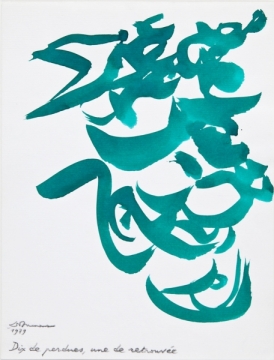The Lettres du désir exhibition, organized at the Bibliotheca Wittockiana by the Archives & Musée de la Littérature (AML), covers the links between correspondence and creativity in French-speaking Belgium between 1880 and 2010. It reminds us that every work of art is born from the great intimacy of artists and writers and transcends into formal invention the movements of desire, drive and encounters.
This exhibition leads the visitor from Verhaeren and Maeterlinck to Suzanne Lilar and Dominique Rolin, terminating in a room entitled ‘Le désir en toutes lettres’ devoted entirely to Christian Dotremont. The room contains work by the inventor of logograms, from his earliest work, shown in this room, to his work dedicated to love and that addressed to his lover, even more so given that she is far away. Dotremont’s meeting with the Danish Bente Wittenberg, who was to become the mythical Gloria, gave birth to this symbiosis and infinite declination.
The last room of the exhibition also highlights a number of pieces from the Christian Dotremont Fund, donated to the King Baudouin Foundation in 2011 by Guy Dotremont and entrusted to the AML in keeping with the donor’s wishes. From his youthful calligraphic exercises on the name Doris to his logograms (‘Je t'aime à perte de goût ‘; ' Horions, Gloria ‘; Gloria et moi logiquions pas, logions au coin des cinq sens et plus ... '), we can observe the creative dynamic of one of the most important post-war poets devoting himself to seeing and dreaming.
In the showcase that introduces the exhibition, is Marcel Mariën’s Les Torches du silence, dedicated to Jacqueline Nonkels. Jacqueline Nonkels was a close friend of René and Georgette Magritte, in whose home she met Marcel Mariën. Marcel Mariën fell in love with the young woman and the correspondence that followed their meeting marked the beginning of a lengthy output of erotic works, peppered with humour. Jacqueline Nonkels bequested these letters to the Foundation, which subsequently entrusted them to the AML.
